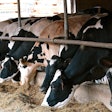Views about the use of phytogenic feed additives (PFAs or botanicals) were provided by 1,140 agribusiness professionals from across the globe as part of the 2017 BIOMIN Phytogenic Feed Additives Survey.
“The response has been tremendous,” said Michael Noonan, Global Product Manager Phytogenics at BIOMIN. “These results confirm that veterinarians, nutritionists, live production managers and other professionals in every region of the world have identified clearly defined benefits to using phytogenics in their operations,” he remarked.
According to BIOMIN projections, the PFA market could surpass $1 billion by 2023.
Perceived benefits
Digestibility enhancement ranked as the number one reason that the livestock industry uses phytogenic feed additives. The antimicrobial effects of phytogenics ranked second overall, and they constituted the top motivation for respondents in the Western hemisphere.
The use of PFAs within an antibiotic growth promoter (AGP) replacement strategy and growth promotion ranked third and fourth place, respectively.
“Research supports the perceived benefits that professionals report in the field,” noted Noonan. Plant-based compounds–specifically essential oils, herbs and extracts–are known to have a range of biologically active properties that can be applied to modern animal production. These include anti-oxidant, anti-inflammatory, anti-microbial and digestion enhancing effects.
Feed conversion key
When asked about the relative importance of the benefits of phytogenic feed additives to their business, respondents overwhelmingly chose enhanced feed efficiency, or an improved feed conversion ratio (FCR) as the most important benefit of PFA application.
“Feed efficiency speaks to the core concern of every livestock and feed producer in a globally competitive market,” observed Noonan. “At BIOMIN, improving feed efficiency has been the main thrust of our research and product development around phytogenics in recent years.”
Challenges
The survey also explored reasons why respondents do not use PFAs. They cited a lack of scientific and commercial trial results along with uncertainty regarding which product to choose as the top 3 reasons not to use phytogenics. BIOMIN has undertaken significant efforts to help overcome these hurdles.
“As part of the BIOMIN commitment to deliver innovative science-based solutions, we co-authored 20 scientific papers on phytogenics in 2016 and conducted over 300 commercial trials on PFAs in recent years,” explained Noonan.
On-farm improvements
Research and education are key to how BIOMIN engages with the industry on phytogenics, as part of its ambition to become market leader in phytogenics by 2020.
“By collecting customers’ views, we gain a greater understanding of where agribusiness professionals see value in the use of PFAs and what challenges they encounter in real life. It’s a way for us to connect science with better outcomes for clients,” said Noonan.
“These results afford us the opportunity to enter into genuine dialogue about the current state of the art in phytogenic feed additives, and how they can apply to specific on-farm scenarios,” he added. BIOMIN deploys a global team of expert technical sales managers who support clients through on-site visits, education and advice.
Participants in the feed additives survey included nutritionists, veterinarians, consultants, growers, owners and live production managers located in over 100 countries representing the feed, poultry and swine sectors.










